Author: Aylo.
Translation: Tim, PANews.
First of all, you cannot successfully escape the peak. You can't do it, I can't do it, and I wouldn't even try.
Cycle tops can appear quickly in a short time but are usually not obvious until confirmed after a long period.
Day traders who focus on short-term trends may seize opportunities, but before that, they have already made too many judgments on cycle tops, and those misjudgments have long lost their significance. Their perspective has never looked at the broader picture.
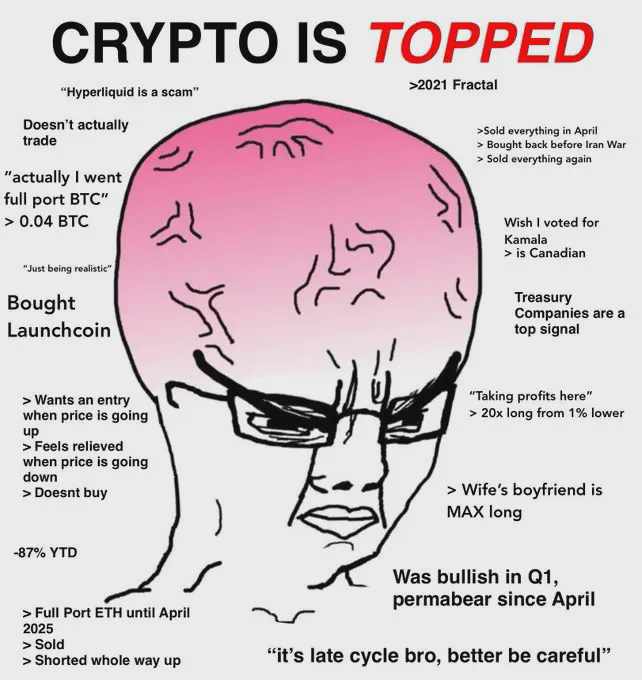
I am just a student currently learning about market trading, still in the stage of accumulating knowledge and experience. I have not yet experienced enough market cycles, so I do not dare to consider myself an expert; I am only being honest here.
Make decisions independently; you bear the profits and losses. I never consider myself a prophet; the emergence of new things often overturns old views.
'Four-year cycle theory' evidence.
Reviewing the historical charts of BTC prices, there is a clear pattern: December 2013, December 2017, November 2021. This four-year cycle has always maintained astonishing regularity, and market patterns tend to persist until a fundamental change occurs.
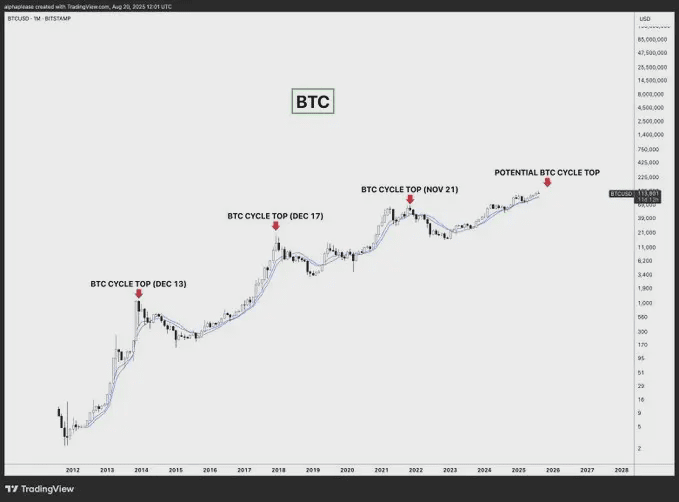
Reasons why the four-year cycle model may continue to hold:
Mindset: The four-year cycle in the crypto market has deeply rooted itself in people's minds.
Self-fulfilling prophecy: collective selling may be triggered by widespread market perception, coupled with leverage factors hidden in the system (like the current digital asset treasury DAT?).
Bitcoin halving correlation: the supply shortage caused by Bitcoin halving events has historically generated price peaks 12-18 months in advance (although in the current cycle, this seems more narrative-driven).
Occam's Razor principle: the simplest explanation is usually the correct one; since it has worked three times, why complicate things further?
(Note: The Occam's Razor principle states that when explaining the same phenomenon using different theories or models, one should prefer the one that makes the fewest assumptions, requires the fewest entities, or is the simplest in form. In other words, try to avoid unnecessary complications.)
We are definitely not in the early stages of this cycle; Bitcoin has risen significantly from the bottom. The four-year cycle model indicates that we are approaching the top of a bull market.
Refuting the four-year cycle theory (i.e., the 2026 bull market theory).
I have a simple question: will the institution-driven cycle really look exactly the same as the previous two retail-driven cycles?
I generally agree with the market cycle theory, so this discussion does not include super cycles, but I believe market cycles can be insufficient or overly extended due to other influencing factors.
Why is this time perhaps really different?
1. Differences in behavior patterns between institutions and retail.
The flow of funds into spot ETFs and traditional exchanges creates a brand new liquidity model.
Institutional profit-taking is more stable than retail behavior, causing less panic.
2. Traditional indicators may have failed.
We have a large number of cycle analysis tools (such as NVT, MVRV, etc.), but their historical applicability is mainly based on retail-dominated markets.
Institutional participation fundamentally changes the situation of 'overly inflated bubbles'.
In terms of gold prices, Bitcoin's current price hasn't even surpassed the previous cycle's peak, so it can't be considered a bubble at all.
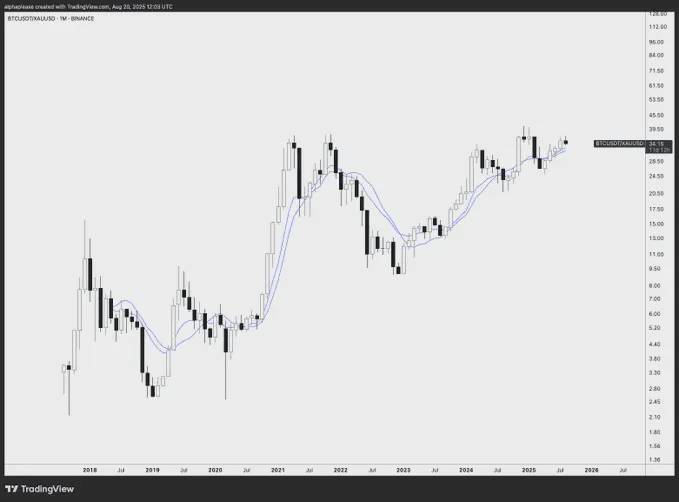
3. Changes in the regulatory environment.
The regulatory environment in this cycle is entirely different; cryptocurrencies have now been accepted by the US and the SEC, and the institutional framework is becoming clearer.
The previous bull market cycle ended partly due to a regulatory storm (like the 2018 crackdown on ICOs).
This systemic sudden risk has essentially eliminated the possibility of a cycle ending.
4. The Fed and macro dynamics.
Federal Reserve Chairman Powell's term will end in May 2026, and Trump may announce a successor at the end of 2025.
"Shadow Fed Chairman" effect not only weakens the current monetary policy's effectiveness but also breeds advanced buying due to market expectations that Trump will nominate a dovish chair.
The first Federal Open Market Committee meeting of the new Fed chair will be held on June 17-18, 2026, which is a potential catalyst event.
The extended 'Goldilocks environment' runs through the economic transition period.
(Note: The Goldilocks environment is an economic term referring to the ideal state of 'high growth + low inflation,' derived from the metaphor of 'just right' in the fairy tale of Goldilocks and the Three Bears.)
Historical patterns indicate that the transition of the Fed chair usually draws market attention.
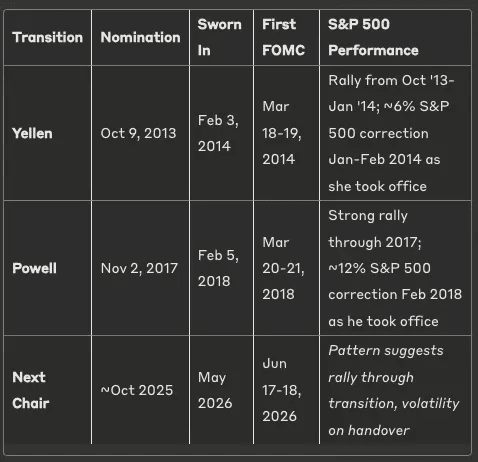
Consistent patterns: both presidential transitions exhibit the same script: nomination news boosts the stock market, the uptrend persists throughout the transition period, but when the new president officially takes office, the S&P 500 always retraces.
During Yellen's transition (January-February 2014), the S&P 500 index fell about 6%; during Powell's transition (February 2018), it triggered about a 12% correction. This suggests that the new chairperson announced by Trump at the end of 2025 may promote a bull market that continues through the transition period, but the power transition phase in May-June 2026 is highly likely to see market turbulence, which may coincide with the cycle top.
5. Market structure changes.
Concerns over currency devaluation are giving rise to new driving factors beyond 'risk appetite'.
The market cap of stablecoins as a leading indicator is currently continuing to grow (our 'reserve' indicator).
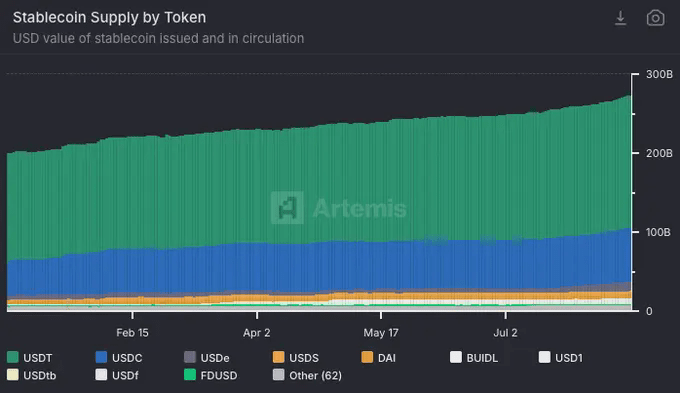
The sources of demand for Bitcoin currently are more diversified than in previous cycles: ETFs, digital asset treasuries, pension funds.
What factors could potentially end the 2026 bull market theory early and lead to the re-emergence of a four-year cycle?
Leverage risk in digital asset treasury: I observe that the most significant bearish factor is that digital asset treasury companies may liquidate their leveraged positions at an unexpectedly fast pace. Large-scale forced sell-offs could crush buying power and change market structure. But we need to distinguish between two situations: losing buying demand (when net asset valuation is still 1) and being forced to sell, triggering a 'chain sell-off'. If the primary treasury purchasing power weakens, it obviously has a significant impact on the market. There are already many signs indicating that this is happening; whether it's Strategy or major ETH treasury institutions, net worth has significantly declined. I do not turn a blind eye to this, nor should you, so it is crucial to keep a close watch on this situation.
Macro risk: inflation rising again is the real macro risk, but I have not yet seen evidence of this. Cryptocurrencies are now highly correlated with the macro environment, and we are still in a Goldilocks economic environment.
Characteristics of a top that has not yet appeared.
Frenzy has not yet arrived.
Concerns always exist: every 5% drop triggers voices claiming the market has peaked (this has continued for 18 months).

There is no continuous frenzy in the market or a unified view on a sustained upward trend.
No top sell-off behavior has been observed (not necessary).
If the crypto market sees a significant rise by the end of this year and greatly outperforms the stock market, this surge signal may indicate that the crypto market peaks ahead of the business cycle, and this business cycle is likely to extend until 2026.
Leading indicators of stablecoins.
A particularly useful indicator: the growth status of stablecoin market cap.
In traditional finance, M2 money supply growth is often a precursor to asset bubbles. In the crypto market, the total market cap of stablecoins plays a similar role, representing the total 'dollar' liquidity available in the crypto market.
Historical data shows that the major cycle tops in the crypto market often appear 3-6 months after the growth of stablecoin supply stagnates. As long as the supply of stablecoins continues to show significant growth, it indicates that there is still ample room for market upward movement.
My current viewpoint.
With a gun to my head, I say that based on current observations, I don't see a major cycle top before 2026 (this viewpoint can change quickly, no need to be overly serious).
We only have three data points regarding the four-year cycle for validation, and institutional participation represents a fundamental change in market structure. The mere news of the Fed chair transition could extend the Goldilocks environment until 2026, which I consider particularly important, especially as the correlation between cryptocurrencies and the macro economy is greater than ever.
In this cycle, market participants have a deeper understanding of the four-year cycle theory, making me feel that the outcome will be different. When have people ever made the right judgment? Are they all ready to follow the four-year cycle rule and sell off together?

However, I acknowledge that this four-year cycle has been remarkably stable, and market patterns often persist until they are broken. When the public starts to realize this cycle, it may very well form a self-fulfilling prophecy that ends the pattern.
I will continue to take profits from altcoins that have surged excessively when Bitcoin's dominance (BTC.D) falls, but I will firmly hold Bitcoin, as I predict it will reach an all-time high in 2026. Please note: regardless of how the current market cycle evolves, your altcoins may peak at any time.
Conclusion.
The four-year cycle law is the strongest argument supporting the theory of a peak in 2025; this pattern has been validated three times, and simple laws often work. However, changes in market structure brought about by institutional investors, the uniqueness of the Fed's policy transition period, and the lack of frenzy signals in the market all suggest that this cycle may extend until 2026.
The next few months will be unpredictable; trying to catch the top is not advisable.
In any case, once you recognize reality and feel you cannot escape the peak, you can start to develop a systematic exit strategy.
The right position is one that allows you to sleep soundly at night. It's okay to sell too early as long as you've made enough profit.
I am absolutely open to hearing all opinions, including opposing ones. Writing this article is to help myself make decisions and to 'learn publicly'.



